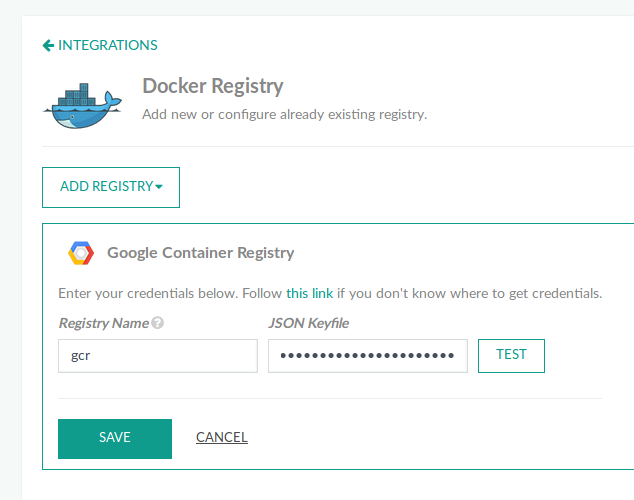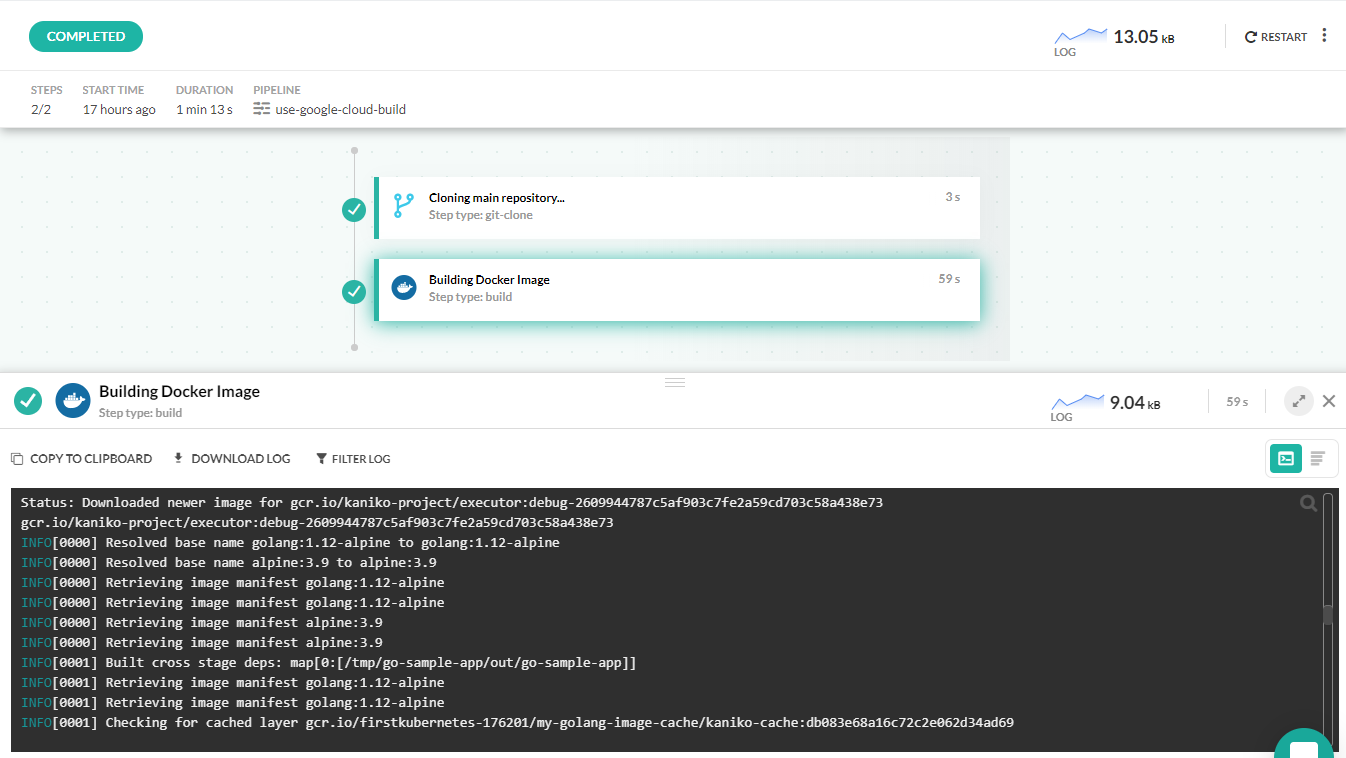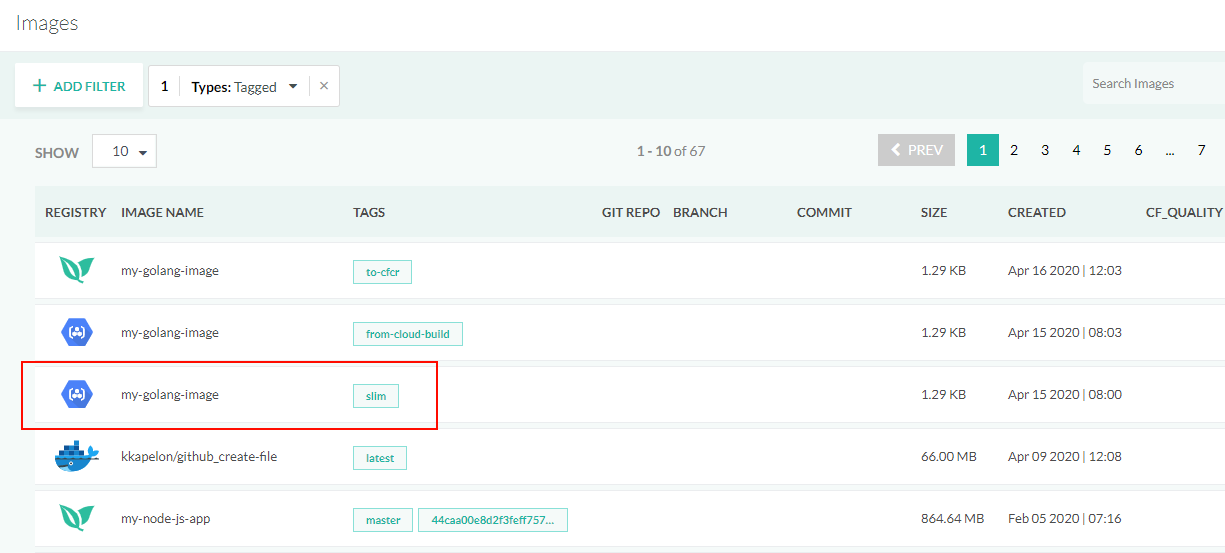Google Cloud Builder pipeline integration
Use the Google Cloud builder to create Docker images in Codefresh pipelines
Google Cloud builder is an online service that allows you to build Docker images using the Google infrastructure and also push them to the Google Cloud registry.
You can also use Cloud builder in a Codefresh pipeline in place of the standard build step. This way you can take advantage of the Cloud builder in your Codefresh pipelines, but still push to other registries that are connected to Codefresh (and not just GCR).
Prerequisites
To use the Cloud builder service in your Codefresh pipeline you need:
- A free Docker Hub account and Docker Hub connected to Codefresh.
- A Google Cloud subscription and a service account for the Cloud builder service.
Save your service account as a JSON file, and make sure you select at least the following roles:
- Cloud storage Admin
- Storage Admin
- Storage Object Viewer
- Storage Object Creator
You will use this JSON file either by integrating a Google Docker registry in Codefresh, or directly in a pipeline as we will see later.
How it works
The Google Cloud builder integration/authentication can be used in the following ways:
- Authentication is retrieved from the GCR integration in your Codefresh account, and the resulting Docker image:
- Is also be pushed to GCR.
- Is pushed to any other external registry connected to Codefresh.
- Authentication is defined in the pipeline itself, and the resulting image can be pushed to any registry connected to Codefresh
In the first case, you will define the service account file centrally in the GCR integration screen, and then any pipeline can authenticate to Google Cloud builder without any further configuration.
Using Google Cloud builder in a Codefresh pipeline
In the most straightforward scenario, you want to create a Docker image with Google Cloud builder and also push to GCR.
Here is the full pipeline:
codefresh.yml
version: '1.0'
steps:
main_clone:
title: Cloning main repository...
type: git-clone
repo: 'codefresh-contrib/golang-sample-app'
revision: master
git: github
MyAppDockerImage:
title: Building Docker Image
type: build
image_name: my-golang-image
working_directory: ./
tag: slim
registry: gcr
dockerfile: Dockerfile.multistage
provider:
type: gcb
arguments:
cache:
repo: "my-kaniko-cache"
ttl: "10h"
The build step of the pipeline has an extra property, provider, that specifies we want to use Cloud builder instead of the Codefresh native build step.
The only required argument is the repository to be used for Kaniko caching and speed up subsequent builds.
NOTE
The Kaniko repo should NOT be the same as the repository used for the image itself.
After runing the pipeline, you will see your Docker image in the Image dashboard.
The Docker image is also visible in the Google Cloud Console view of your registry.
Pushing to a different registry
Even though the Cloud builder pipeline step authentication is fetched from the GCR configuration, you don’t have to push to GCR.
To push the Docker image to another connected registry, simply change the registry property in the build step.
The pipeline in the example below pushes the Docker image created to another registry that is identified by Azure.
codefresh.yml
version: '1.0'
steps:
main_clone:
title: Cloning main repository...
type: git-clone
repo: 'codefresh-contrib/golang-sample-app'
revision: master
git: github
MyAppDockerImage:
title: Building Docker Image
type: build
image_name: my-golang-image
working_directory: ./
tag: slim
registry: azure
dockerfile: Dockerfile.multistage
provider:
type: gcb
arguments:
cache:
repo: "my-kaniko-cache"
ttl: "10h"
Authenticating to Cloud Builder in the pipeline
If you don’t want to reuse the Registry integration provided by Codefresh for easy authentication to Google Cloud builder, you can also use your service account JSON file directly in the pipeline.
You can pass the contents of the JSON file as a variable in the pipeline and the build step will use it to authenticate.
codefresh.yml
version: '1.0'
steps:
main_clone:
title: Cloning main repository...
type: git-clone
repo: 'codefresh-contrib/golang-sample-app'
revision: master
git: github
MyAppDockerImage:
title: Building Docker Image
type: build
image_name: my-golang-image
working_directory: ./
tag: slim
registry: azure
dockerfile: Dockerfile.multistage
provider:
type: gcb
arguments:
google_app_creds: '${{G_CREDS_B64}}'
cache:
repo: "my-kaniko-cache"
ttl: "10h"
Here the pipeline will try to authenticate to Google Cloud builder using the contents of the google_app_creds property.
The value of this property can be a pipeline variable, or project variable or any other standard Codefresh method such as shared configuration.
You need to escape the contents of the service account before you use in the pipeline with either of these commands on your local workstation:
cat _json_key_file | base64 | tr -d ‘\n’cat _json_key_file | base64 -w 0
Using extra properties for Google Cloud builder
The build step has several other properties can be used to fine-tune the Google Cloud builder behavior.
Here is the full syntax:
step_name:
type: build
title: Step Title
description: Free text description
working_directory: ${{clone_step_name}}
dockerfile: path/to/Dockerfile
image_name: owner/new-image-name
tag: develop
build_arguments:
- key=value
target: stage1
no_cache: false
no_cf_cache: false
fail_fast: false
registry: my-registry
provider:
type: gcb
arguments:
google_app_creds: '${{G_CREDS_B64}}'
cache:
repo: "repositoryname/kaniko-cache"
ttl: "10h"
timeout: "600s"
machineType: 'N1_HIGHCPU_8'
logsBucket: "gs://your-project_cloudbuild/logs"
diskSizeGb: 10
The extra fields are:
| Field | Description | Required/Optional/Default |
|---|---|---|
type |
Defines which provider to use (currently gcb and cf types are available). It uses cf provider by default and the whole provider section can be omitted for a regular build step. |
Required |
arguments |
Parameters for Google Cloud builder | Required |
google_app_creds |
base64 encoded string of the Google app credentials JSON. By default, taken from the existing GCR integration. | Optional |
cache |
The list of Kaniko cache parameters | Required |
repo |
Docker repository path for the Kaniko cache | Required |
ttl |
Kaniko cache retention. Default value is 336h |
Optional |
timeout |
This field is directly translated into the corresponding field of the GCB manifest file. Default is 10m |
Optional |
machineType |
This field is directly translated into the corresponding field of the GCB manifest file. | Optional |
diskSizeGb |
This field is directly translated into the corresponding field of the GCB manifest file . | Optional |
logsBucket |
This field is directly translated into the corresponding field of the GCB manifest file. | Optional |
The step also accepts all the fields of the standard build step, but notice that the following fields are not supported in the current implementation and simply ignored by the GCB step logic:
no_cache- All the buildkit related fields
Here is an example that uses all possible fields:
YAML
GCBuild:
type: build
image_name: '${{IMAGE_NAME}}'
working_directory: ${{CloneStep}}
tag: your-tag1
tags:
- your-tag2
- your-tag3
target: 'test'
no_cf_cache: false
metadata:
set:
- qa: pending
build_arguments:
- WORD=Hello
registry: 'reg-integration-name'
dockerfile:
content: |-
FROM alpine as test
RUN apk add skopeo
ARG WORD
RUN echo $WORD
provider:
type: gcb
arguments:
google_app_creds: '${{G_CREDS_B64}}'
cache:
repo: "repositoryname/kaniko-cache"
ttl: "10h"
timeout: "600s"
machineType: 'N1_HIGHCPU_8'
logsBucket: "gs://your-project_cloudbuild/logs"
diskSizeGb: 10
Related articles
Creating pipelines
Steps in pipelines
Google Container Registry integration
Build and push an image example


